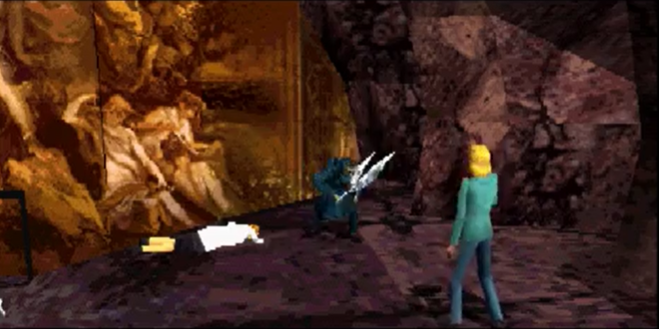In 1996, Human Entertainment released Clock Tower, a point-and-click horror adventure for the Sony PlayStation. While Capcom’s contemporaneous Resident Evil had cornered the market for zombie-movie gaming, Clock Tower aimed toward something of a hybrid between an Italian giallo film and a cheap slasher flick. While the game is slower-paced and more heavily dialogue-based Resident Evil, Clock Tower markedly surpasses Capcom's eventual classic when it comes to the most crucial element of horror cinematography—that is, atmosphere. The whodunit plot takes multiple characters through dank dungeons, spider-webbed libraries, and labyrinthine castle halls, settings which altogether apotheosize foreboding. Moreover, Clock Tower is well-written and well-voiced, at least relative to Resident Evil. This contributes to an immersiveness that produces legitimate chills, none greater than the experience of encountering the villain: a gaunt, cretinous hunchback wielding an exaggeratedly long pair of pruning shears as his trademark weapon. He goes by the baroque sobriquet of Scissorman.

Scissorman inherits a ghastly horror legacy, as he represents a bloodcurdling copy of a copy. He was quite obviously inspired by Cropsey, nemesis in the 1981 slasher-cycle feature The Burning, a bandage-faced summer camp caretaker-cum-burn-victim out to avenge his first-degree misadventure by slaughtering camp-goers with gardening shears. While The Burning is a blatant carpetbagger clone of Friday the 13th, it actually outdoes that film as far as lakeside slashing goes, and though it failed at the box-office, it stands as one of the higher-end slice-em-up films. Its canoe scene is legendary in cult cinema circles—when Cropsey springs up, a silhouette of a ragged, carbuncular man with gaping shears raised above him, he reduces Jason Voorhees to a sluggish, silver-medal serial-killer. The Burning marks the feature film debut of George Costanza; or, if you prefer, Jason Alexander. The Burning is also notable for being among the first production credits for acclaimed Hollywood producer and recently-outed serial-groper Harvey Weinstein. Weinstein wrote the original story and thereby had a hand in conceiving the character of Cropsey. Given the violent sexual angst that seems to motivate most slasher villains, one can only imagine what nascent erotic compulsions Weinstein sublimated into Cropsey. Perhaps some of those dark inspirations filtered down to Scissorman. Could it be that when Scissorman chases us in Clock Tower, it is some faint, transmuted vestige of Harvey Weinstein's burning libido that impels the pursuit?
But we've drifted somewhat far afield here. Regardless of the psychic source of the spookiness it delivers, the Clock Tower experience is evidently one for which dedicated horror gamers are willing to shell out exorbitant sums of cash. Indeed, copies in decent condition will fetch over $100 on EBay, and with good cause. Like any good slasher baddie, the game's terror has proven unkillable. And if you can't afford the game, you should at least check out The Burning.